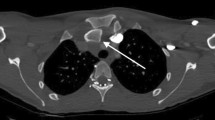Abstract
Dislocation of the sternoclavicular joint can be associated with life-threatening complications; therefore, a thorough knowledge of the ligaments contributing to sternoclavicular joint stability is essential for the clinician dealing with this anatomical area. The aim of our study was to examine the anatomy of the interclavicular ligament. We examined 50 human cadavers. The interclavicular ligament was identified in 90% of the specimens. The interclavicular ligament was located at the base of the sternal notch in 50% of the cases and connected the superior portions of the capsule of the sternoclavicular joints of each side. The interclavicular ligament connected with the posterior superior aspect of each medial end of the clavicle and with the fibers of the posterior and anterior interclavicular ligaments forming a continuous ligamentous layer. The mean length of this ligament was 2.1 cm, the mean width was 0.72 cm and the mean thickness was 0.36 cm. With the elevation of the shoulder joint and the abduction of the humerus, the interclavicular ligament remained lax. With the depression of the shoulder joint and the adduction of the humerus, this ligament became fully taut. As a result, the interclavicular ligament prevented the upward displacement of the clavicle during forceful depression of the humerus and the shoulder. The tensile force necessary for failure was >53.7 N/cm2 in all the specimens. These data may be useful to surgeons for instituting techniques for surgical procedures that reconstruct the sternoclavicular joint. Moreover, a future study aimed at evaluating the long-term consequences of surgical transection of this ligament may be in order.




Similar content being viewed by others
References
Benitez Cl, Mintz DN, Potter HG (2004) MR imaging of the sternoclavicular joint following trauma. Clin Imaging 28:59–63
Clemente CD (1985) Articulations of the upper extremity in Gray’s Anatomy, 30th edn. Williams & Wilkins, Baltimore p 367
Cope R (1993) Dislocations of the sternoclavicular joint. Skeletal Radiol 22:233–238
Colhoun EN, Hayward C, Evans KT (1987) Inter-sterno-costo-clavicular ossification. Clin Radiol 38:33–38
Ferrera PC, Wheeling HM (2000) Sternoclavicular injuries. Am J Emerg Med 18:58–61
Gardner MAH, Bidstrup BP (1983) Intrathoracic great vessel injury resulting from blunt chest trauma associated with posterior dislocation of the sternoclavicular joint. Aust N Z J Surg 53:427–430
Jougon JB, Lepront DJ, Dromer CEH (1996) Posterior dislocation of the sternoclavicular joint leading to mediastinal compression. Ann Thorac Surg 61:711–713
Kennedy JC (1949) Retrosternal dislocation of the clavicle. J Bone Joint Surg 31:B74–B75
Lore JM, Martin PT, Koch RJ, Sittitrai P, Sundquist N (1995) Access to the superior mediastinum. Am J Surg 169:348–354
Morris H (1879) Anatomy of the Joints. J & A Churchill, London, p 190
Nada M, Shiraishi H, Mizuno K (1997) Chronic posterior sternoclavicular dislocation causing compression of a subclavian artery. J Shoulder Elbow Surg 6:564–569
Nettles JL, Linscheid RL (1968) Sternoclavicular dislocations. J Trauma 8:158–163
Neumann DA (2002) Upper extremity in Kinesiology of the musculoskeletal system foundations for physical rehabilitation. St. Louis, Mosby, p 100
Ono K, Inagawa H, Kiyota K, Teradda T, Suzuki S, Maekawa K (1998) Posterior dislocation of the sternoclavicular joint with obstruction of the innominate vein: case report. J Trauma 44:381–383
Rayan GM (1994) Compression brachial plexopathy caused by chronic posterior dislocation of the sternoclavicular joint. J Okla State Med Assoc 87:76–78
Shearman CM, El-Khoury GY (1998) Pitfalls in the radiologic evaluation of extremity trauma: Part I. The upper extremity. Am Fam Physician 57:995–1002
Spencer EE, Kuhn JE, Huston LJ, Carpenter JE, Hughes RE (2002) Ligamentous restraints to anterior and posterior translation of the sternoclavicular joint. J Shoulder Elbow Surg 11:43–47
Standring S (2005) Pectoral girdle, shoulder region and axilla in Gray’s Anatomy. 39th edn. Elsevier, Edinbourough, p 827
Thorek P (1951) Anatomy in surgery. J.B. Lippincott, Philadelphia, p 265
Wasylenko MJ, Busse EF (1981) Posterior dislocation of the clavicle causing fatal tracheoesophageal fistula. Can J Surg 24:626–627
Author information
Authors and Affiliations
Corresponding author
Rights and permissions
About this article
Cite this article
Shane Tubbs, R., Loukas, M., Slappey, J.B. et al. Surgical and clinical anatomy of the interclavicular ligament. Surg Radiol Anat 29, 357–360 (2007). https://doi.org/10.1007/s00276-007-0219-z
Received:
Accepted:
Published:
Issue Date:
DOI: https://doi.org/10.1007/s00276-007-0219-z




